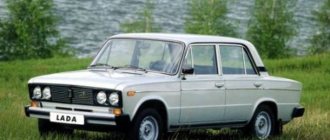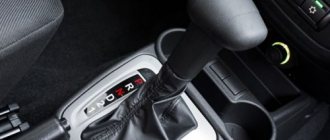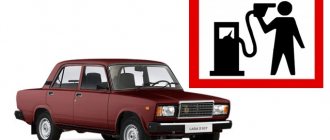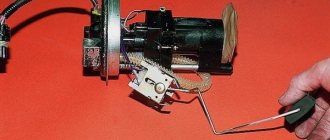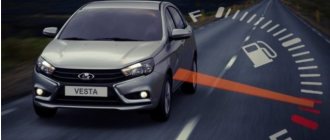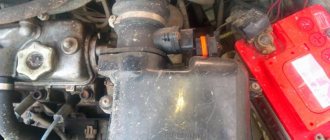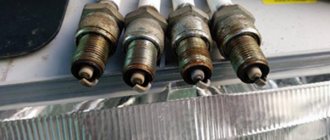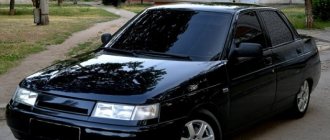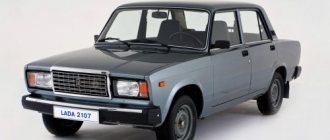There are four main models of the Lada Kalina passenger car:
- sedan - has a closed body, with 2-3 rows of seats for the driver and passengers, the trunk is separated from the car interior, there is no lifting door in the rear wall;
- station wagon - has a closed cargo-passenger body, one of the sedan variants, which has an enlarged luggage compartment, is equipped with a lifting door in the rear wall;
- hatchback - has a body with 1-2 rows of driver and passenger seats, with a shortened rear overhang (hence the name - “hatchback” means “short”) and a smaller luggage compartment, equipped with a lift-up door in the rear wall;
- sport - is a sports version, which is equipped with a number of special parts - a bumper, an exhaust pipe tip, sports pedals, alloy wheels, a SAAZ Sport sports suspension, front and rear disc brakes, an original reinforced gearbox.
As you can see, the main difference between each model is its body type. Gasoline consumption (unleaded AI-95) is calculated in liters over a driving cycle, which is 100 kilometers.
In this case, the following parameters of the vehicle itself are taken into account:
- Engine size (Lada Kalina comes in two types - 1.4 l and 1.6 l).
- Number of valves (for Lada Kalina - 8 and 16).
Experts have prepared an information table that shows the factory fuel consumption indicators for each model of the Lada Kalina passenger car, taking into account the mandatory parameters.
Model Lada Kalina
1.6 l (8 valves)
The manufacturer sets the standards for digital fuel consumption indicators for each Lada Kalina model based on the results of test runs of passenger cars on a special track. But on the track, driving conditions are reduced to ideal, and the car is driven by an experienced driver. In real conditions, everything becomes much more complicated. In addition, the speed indicator during real driving is not always within the required limits - from 100 km/h to 120 km/h. This is due to the fact that some drivers do not recognize the established framework for optimal driving of a Lada Kalina car, which significantly affects fuel costs.
Lada Kalina 2004 - 2013
First cars
The first production sedan was equipped with a 1.6-liter eight-valve engine. The production of this engine was well tested and familiar. It almost completely, with minor improvements, repeated the design of the power unit of the VAZ G8, but only its volume increased. Power 82 hp enough to complete the assigned tasks - driving in city traffic and driving on the highway at the speed allowed in Russia.
New bodies and engines
Since 2006, cars with a hatchback body began to roll off the assembly line, and in 2007 a station wagon appeared. The evolution of power units was continued by a motor with the same volume, but with a 16-valve mechanism. The car's power has increased, and so has its acceleration dynamics. Unfortunately, the fuel consumption of the Lada Kalina often exceeded the figures stated by the manufacturer. They tried to reduce it by reducing the engine volume from 1.6 to 1.4 liters. Power dropped by 20 hp. s., but the new engine actually consumed less gasoline.
Gearbox and features of the first generation
All Kalinas until 2013 were equipped with a 5-speed manual transmission. The fuel injection and ignition processes are controlled electronically. During its release, the model acquired an anti-lock brake system, electric power steering and air conditioning, which was installed on upgraded cars.
Fuel consumption depending on engine
- The 8-valve engine with 1600 cc capacity is characterized by low power but excellent torque. When the load increases, there is often no need to downshift. The advantage is that damage to the timing belt will not cause the valves to collide with the pistons, and they will not be deformed. The downside is that it is noisy during operation. When driving on the highway at a speed of 90 km/h, the claimed consumption is 5.5 liters per 100 km.
- The 1.6-liter power unit, equipped with sixteen valves, is significantly more powerful than its predecessor, but its thrust has decreased. It is more capricious in terms of fuel and oil, its maintenance and repairs are more expensive. True, it also consumes less gasoline: according to the manufacturer, consumption on the highway is about 5 liters, in the city - 7 liters, mixed - 6 liters. The actual figures are slightly higher. The main reason for greater efficiency with increased power is better efficiency when consuming the fuel-air mixture, faster fuel supply to the cylinder and exhaust gas output.
- The most economical is the smaller engine with 16 valves. The revolutions have increased to 4.5 thousand per minute, but driving with a load in high gear is unlikely to be possible. If the timing belt breaks, there is a risk of bending the valves, and this will affect the cost of repairs.
| Modification | 1.6, 8 grades, 5 grades. Manual transmission | 1.6, 16 grades, 5 grades Manual transmission | 1.4, 16 grades, 5 grades Manual transmission |
| Consumption city, l/100 km | 7,7 | 9,8 | 8,5 |
| Route, l/100 km | 5,5 | 6 | 5,5 |
| Combined cycle consumption, l/100 km | 7,5 | 7,2 | 7,5 |
| Acceleration, sec up to 100 km/h | 13,5 | 12 | 12,5 |
High fuel consumption Lada Kalina: reasons, repairs
This is the idle consumption. or 1.2 all the same?
in winter around the city with warm-ups for 5-10 minutes? then this is normal consumption.
It’s just that in the summer I drive around the city with the same engine (without powerful acceleration) and it comes out to 8 liters.
There are no statistics yet in winter, but I don’t think there will be 15.
This is the idle consumption. or 1.2 all the same?
in winter around the city with warm-ups for 5-10 minutes? then this is normal consumption.
My Kalina shows an average consumption of 19.9, while the Priora shows 18.3. There is no need to go anywhere, everything works fine. In addition, the “injector operator” will not be able to tighten anything, nothing is tightened there. Reset the computer, and drive along the highway for 10 kilometers at a speed of 80, and then look
Everything will be fine.
Is this on the highway or what?
Is this on the highway or what?
Is this on the highway or what?
Take a ride along the highway. It’s quite normal for the city in winter, my consumption is higher, although I have short trips with frequent stops (slowing down) in front of pedestrians, traffic lights, etc.
I tried it on purpose. For eight kilometers, without traffic jams, in the city, it showed 8.3. While I was standing, consumption increased to 14 liters. We now work more with the engine than we drive, which is why consumption has increased. Everything's fine, don't worry, it's winter
I tried it on purpose. For eight kilometers, without traffic jams, in the city, it showed 8.3. While I was standing, consumption increased to 14 liters. We now work more with the engine than we drive, which is why consumption has increased. Everything's fine, don't worry, it's winter
so this is average, but from the first post everyone thought that your instantaneous consumption at idle was 12 l/h)))
you still need to focus on the average speed (of course, this will not reflect all operating conditions, but it’s still better than describing it in words)
I remember how I reset it when starting the engine, then, when I started driving, I got stuck in a traffic jam. So in this mode, I showed an average of about 20 liters per 100 km, and the average speed was 6 km/h (i.e., the consumption more or less corresponds to the average speed)
Now my consumption is 10.5 liters per 100 km, average speed is 20 km/h
PS, of course, I have a priority engine, but I think the numbers are approximately the same
PSS, to get accurate numbers, you need to reset the computer, fill the tank full, roll it out and see the average consumption and average speed (you can also fill the full tank at the same gas station and do the calculations yourself to make sure the computer’s calculations are correct)
So the tank is full, 100 km on the odometer and again the tank is full, and there will be an error due to foam, car tilt, etc., etc.
Lada Kalina 11174, 11194, BOSH 7.9.7+, B174CR03 Comfort-2010 V 3.8 from D.Dmitriy
So the tank is full, 100 km on the odometer and again the tank is full, and there will be an error due to foam, car tilt, etc., etc.
forgot to underfill
1. look at the fuel pressure in the rail.
2. look at the engine temperature. not the one on the dashboard, but the one that the controller sees, this is another temperature sensor. Should not be lower than 90 gr.
3. valve adjustment (not from the officials, but from a normal specialist or yourself)
4. install the split gear and adjust the beginning of the overlap and then the “traction”. Keep the gear in place and turn the camshaft back half a tooth.
5. flash the latest official firmware.
6. check the explosives with a tool. (instructions on the Internet
7. make a diagnosis with a normal diagnostician using a motor tester and a pneumatic tester.
8. Remake all the masses. It is necessary to have a separate ground wire for the body-body controller and also the body-generator, engine-body.
That is, the voltage on the controller should not ideally be around 14 volts. For cars from the factory it jumps from 13.6 and above. When the voltage is reduced, the controller increases the injection time... richens the mixture and this is consumption.
9. well, pump up the wheels to 2.5 or something
for a cable of about 5.9, city highway 9 is ideal.
There are many questions about consumption and they are relevant, but there are very few answers on the Internet.
1. look at the fuel pressure in the rail.
2. look at the engine temperature. not the one on the dashboard, but the one that the controller sees, this is another temperature sensor. Should not be lower than 90 gr.
3. valve adjustment (not from the officials, but from a normal specialist or yourself)
4. install the split gear and adjust the beginning of the overlap and then the “traction”. Keep the gear in place and turn the camshaft back half a tooth.
5. flash the latest official firmware.
6. check the explosives with a tool. (instructions on the Internet
7. make a diagnosis with a normal diagnostician using a motor tester and a pneumatic tester.
8. Remake all the masses. It is necessary to have a separate ground wire for the body-body controller and also the body-generator, engine-body.
That is, the voltage on the controller should not ideally be around 14 volts. For cars from the factory it jumps from 13.6 and above. When the voltage is reduced, the controller increases the injection time... richens the mixture and this is consumption.
9. well, pump up the wheels to 2.5 or something
for a cable of about 5.9, city highway 9 is ideal.
Thanks for the rare sensible advice! Did it all. Here's one thing: in winter, such consumption as in spring, summer comes almost within the norm. This means that the sensor is also not correct. gives information (by the way, I measured the resistance at different temperatures of antifreeze - it corresponds, in winter the temperature on the tidy rarely approaches 90, and then in traffic jams or at a warm above-zero temperature, this is not clear, I understand at - 25 is another matter, but basically this is the temperature regime in winter .
In winter, I cover half the face with film so that my lawn mower warms up at all.
Lada Kalina 11174, 11194, BOSH 7.9.7+, B174CR03 Comfort-2010 V 3.8 from D.Dmitriy
Last edited by: alex418 (18 August 2021 14:07), edited 1 time in total
But I want to repeat myself, Kalina-1 with e-gas eats gasoline in buckets due to not warming up to 90 degrees.
The situation here is very interesting and almost not voiced on the Internet.
The working thermostat keeps the temperature at -+85 and the “economy mode” in the Kalina firmware starts from 85-87, respectively, even in the summer on the highway, according to the Kalina controller, you are driving with an unheated engine
there are two options
1. edit the firmware
2. sharpen the thermostat rod by 1.5-2 mm
Reduction in consumption by approximately 1 liter.
A forum user for more than 3-4 years and not knowing obvious things about viburnum diseases is probably a flooder or on the payroll of AvtoVAZ
But I want to repeat myself, Kalina-1 with e-gas eats gasoline in buckets due to not warming up to 90 degrees.
The situation here is very interesting and almost not voiced on the Internet.
The working thermostat keeps the temperature at -+85 and the “economy mode” in the Kalina firmware starts from 85-87, respectively, even in the summer on the highway, according to the Kalina controller, you are driving with an unheated engine
there are two options
1. edit the firmware
2. sharpen the thermostat rod by 1.5-2 mm
Reduction in consumption by approximately 1 liter.
What about the law of conservation of energy? After all, if it eats a lot, then the energy from burning more fuel must go somewhere? Those. the cart either has to fly like a meteor, or get terribly warm (you yourself wrote about not warming up).
Again, what about feedback on the recreation center? Is it really not working and there is no oxygen in the gases? (It is checked elementary).
I drove for half the summer with a faulty ECM sensor - the controller saw the engine temperature 8-10 degrees lower than it actually was. Those. According to your version, the consumption should be large. In reality, before the problem was solved, 7.3 l, after 7.2 l/100. True, I have a cable drive DZ.
Have you tried to find answers on the Kalinovsky forum?
What about the law of conservation of energy? After all, if it eats a lot, then the energy from burning more fuel must go somewhere? Those. the cart either has to fly like a meteor, or get terribly warm (you yourself wrote about not warming up).
Again, what about feedback on the recreation center? Is it really not working and there is no oxygen in the gases? (It is checked elementary).
I drove for half the summer with a faulty ECM sensor - the controller saw the engine temperature 8-10 degrees lower than it actually was. Those. According to your version, the consumption should be large. In reality, before the problem was solved, 7.3 l, after 7.2 l/100. True, I have a cable drive DZ.
A forum user for more than 3-4 years and not knowing obvious things about viburnum diseases is probably a flooder or on the payroll of AvtoVAZ
What about the law of conservation of energy? After all, if it eats a lot, then the energy from burning more fuel must go somewhere? Those. the cart either has to fly like a meteor, or get terribly warm (you yourself wrote about not warming up).
So that means everything is fine - as you press a slipper, so is the consumption?
You can not
reply to messages
You can not
edit your messages
Materials: https://autolada.ru/viewtopic.php?t=340378
Technical condition of the car
During break-in, Kalina's engine heats up a little more than usual. This is due to increased friction between parts of the car. As a result, fuel consumption increases. Driving a car with insufficient oil level or poor quality will lead to the same result. The latter is especially worth considering due to the fact that Kalina is equipped with a line of modern engines that are very critical to lubricants.
It is extremely rare for a new car to be faulty. Another thing is the firmware of the control unit. The factory setting has settings intended for engine running-in and subsequent operation under average conditions. According to some owners, this is the cause of gluttony. In this regard, especially desperate car enthusiasts “upload” new ECU firmware. After this, according to them, consumption decreases.
The cause of gluttony may be a faulty catalyst, which is equipped in the exhaust system of all Kalinas without exception. As a result of the formation of soot in it, the filling of the cylinders with air deteriorates, which leads to incomplete combustion of the fuel mixture.
The engine loses its inherent dynamics, and the on-board computer shows higher fuel consumption. The same thing happens if there is a malfunction of the mass air flow sensor. In this case, errors occur in the electronic engine control system. To avoid this, you need to change the air filter more often.
conclusions
If the on-board computer shows significantly more than 8.5 liters (and this is the average consumption in mixed mode), then this is a reason to think about the proper operation of the engine and its systems
If an increase in fuel consumption is detected on the Lada Kalina, the malfunction should be immediately diagnosed and repaired. There were cases when consumption reached 20 liters and only after that did motorists begin to do something. If the owner of a Lada Kalina cannot detect the fault himself, then it is worth contacting a car service center. The consequence of increased consumption may be increased wear of the elements of the power unit, which can lead to unplanned overhauls.
Standard consumption
According to the passport, Kalina in a mixed cycle in the city consumes:
- 7 liters of gasoline per 100 km with a 1.4 liter .
- 7.2-7.8 liters for 1.6 liter .
Real data
- Engines with a volume of 1.4 liters consume about 8.4 liters of fuel in the city. On the highway, consumption is 6.2 liters. In the mixed cycle - about 7.3 liters . These figures were obtained using AI-95 gasoline.
- 1.6 liter engines consume a little more. In the city - 9 liters , and on the highway - 6.8 liters . Accordingly, in a mixed cycle the consumption is about 8 liters .
Winter period
Winter fuel consumption increases significantly during snowfall - the flow speed decreases and, as a result, you have to drive in lower gears.
In winter, the indicator depends on the warm-up time. There is also an empirical dependence on air temperature. The colder it is outside, the more difficult it is for the engine to work (the mechanisms and belts are “oak”).
Our consumption is no less than 10 liters per 100 km . This is on a 16- valve engine with a power of 98 hp .
Thus, the factory figures are slightly underestimated. But in general, Kalina can be considered an economical car.
Lada Kalina Hatchback Che'RNICHKA › Logbook › It was worth it! (Tests to reduce fuel consumption).
Hi all! So let’s summarize the results of tests to reduce fuel consumption. I’ll say right away that this is not advertising, everything was done only for myself and in order to save the family budget, these results are applicable only for my specific car, region of residence and driving style. So, I carried out all the tests along the highway at a speed of 90 km/h, the gasoline rolled out almost to the point of melting (the arrow almost bent in the opposite direction))) I tested: 1) 92nd gasoline from 4 gas stations, 2) then the same using acetone, 3 ) further after installing the “Bugaets” candles, and also 4) with them and acetone. 5 days for each test, about the same amount of gas for 1000 rubles (about 35 liters) was enough for me when covering 110-120 km per day. I didn’t believe in miracles, but in vain))) the car runs one and a half to two times quieter, the traction is noticeably better, and the consumption is less. The result is that I continue to drive on these spark plugs, for every 35 liters (
1000r) - 0.5 acetone, and then we’ll see))) I tabulated the results and the consumption is given in liters per 100 km: Smooth roads everyone!
Mileage: 90,800 km
Financial life
Daewoo Matiz SMALLCAR (STEPWAY) › Logbook › FUEL CONSUMPTION.
HELP immediately (Lada Kalina 1.6 8 valve.) Hello everyone, well, I decided to ask you to advise me on the car of my beloved girl. We have a Lada Kalina 2007 with a 1.6 engine (8-valve) with a mileage of 95 thousand km, since the summer the on-board computer built into the device panel began to frighten the fuel consumption: it was at least 9.8-10.2 liters, on my own I replaced the spark plugs, oil, all filters and thereby achieved a consumption of 9.6-10 liters in the city, which by and large does not make me happy ((maybe I’m not asking for the real thing?) But after reading the forums and the operating manual Lada Kalina with such an engine in the city must consume 7.8-8.5 liters. On the highway, the consumption is approximately 6-7 liters if you do not drive more than 110 km. And the Kalina also has the usual knocking when the engine is running, as it turned out later for Kalinas either the valves or the camshaft itself)) when cold it’s very audible
((, when warm, the knocking sound is less audible. Now the consumption of viburnum is 11.4 liters, the car drives in short runs to work 7 km and back, besides this, I realize that based on this the consumption is still huge ((, but it’s not very big for you I think?) The engine is covered with felt, it warms up normally in the heat of the cabin.) Please advise where to start?) Is it worth coming in to adjust the valves?) Is it worth coming in to wash the injector?) Can a service station check that the injectors are supplying gasoline correctly)?
PS Is it possible that the viburnum’s brains have been rewired with some kind of sports program), due to the fact that it drives very quickly) and don’t think that I’m a person from a vegetable Matiz, where the engine is smaller in quantity than a carton of milk, I think so, but so says my father-in-law, who has a viburnum with a similar engine, but it drives much worse)!
PS2 With my matizyara everything is normal, the mileage has exceeded 73 thousand), has faded into the background) I’m working on viburnum. )
Fuel consumption Lada Kalina
Interesting posts
- How to calculate compensation upon dismissal in 2014
- How to get rid of an LLC with debts
- Where to study to become a financial analyst
Similar articles that you will probably be interested in:
Every Russian knows the VAZ-2107. If on the street, everyone will find in their memory several moments from fate that are connected with this...
The purebred American “monster” Chevrolet Tahoe dates back to 1995, at the time when its sales started. GM originally intended...
Added to Fuel consumption // Real reviews from owners about the fuel consumption of the Kia Spectrum: 1.6 liter engine Fuel consumption of the Kia…
Added to Fuel consumption // 1 Comment Real reviews from owners about the fuel consumption of the Nissan Qashqai: Version of the car with a 1.6 horsepower engine,…
Ford's compact car is hardly lacking in presentation. One of the most sold brands in Europe on the domestic market…
VAZ 2109 is a member of the Lada Sputnik family. Available only in a 5-door hatchback body. The car was put on the assembly line back in Soviet 1987...
Modifications and consumption rates
Having studied the technical characteristics of the Lada Kalina, gasoline consumption can be said to fluctuate slightly up or down. Thus, fuel consumption on the 8-valve Lada Kalina in practice reaches 10 - 13 liters in the city and 6 - 8 on the highway.
Although the gasoline consumption rate for the 2008 Lada Kalina, with proper care and use, should not exceed 5.8 liters on the highway and 9 liters within the city. Gasoline consumption of the Lada Kalina Hatchback in the city does not exceed 7 liters.
| Engine | Consumption (highway) | Consumption (city) | Consumption (mixed cycle) |
| 1.6i l | 5.8 l/100 km | 9 l/100 km | 7 l/100 km |
The actual fuel consumption of the Lada Kalina per 100 km from different owners, according to reviews, is slightly different from the norm:
- consumption within the city is 8 liters, but in reality – more than ten liters;
- on a highway outside a populated area: the norm is 6 liters, and owners report that the figures reach 8 liters;
- with a mixed driving cycle - 7 liters, in practice the figures reach ten liters per 100 km.
Review
People called the Lada-Kalina the improved Granta. This is all visible in the interior materials, sound insulation, and the principle of engine operation. Thanks to this, the Lada Kalina's fuel consumption per 100 km is 7.1 liters.
As for the differences from the previous generation, progress is noticeable here. In the older version, handling was at a low level, poor steering response to driver movements made car owners very nervous. Therefore, AvtoVAZ engineers carried out work to reduce the length of the steering rack. Thanks to this, the steering wheel now makes not four full turns, but three. An electric power steering from a Korean manufacturer was also installed, which significantly improved steering control.
Thanks to the work of engineers, the transmission was updated, which also caused a lot of inconvenience. Now changing gears has become much easier, vibration has been eliminated, the gearshift lever travel has become shorter, and gear shifting has also become softer.
As for the technical characteristics of the Kalina, a new engine with a capacity of 106 horsepower was added to the engine line. But the drivers didn’t like it. Acceleration has not become noticeably faster, it feels like almost nothing has changed, so there is no point in paying a transport tax of a couple thousand more. Car enthusiasts prefer the previous 98 horsepower engine.
Noise insulation is poor, just like in the previous generation. After all, AvtoVAZ decided to completely abandon fender liners to save money. But the company promised to correct this defect and install them on the new generation.
The updated design looks fresher, but the shapes are still the same. Very large side mirrors look ridiculous given the size of the car. But besides this, there are a lot of positive changes. The fuel consumption per 100 km of the Lada Kalina has also been changed; it is significantly less than its predecessor due to the updated engine.
The new generation in top versions has a large touch display. The updated version removed the disk drive, but now it is possible to listen to music from flash drives and SD cards. The display fits perfectly into the car's interior. The dashboard now has a speedometer, tachometer and a small display between them.
The gear lever began to look more attractive compared to the previous generation, both in the version with automatic and manual transmission.
There are a number of new airbags, which are now located both above the glove compartment and in the front doors. The deflectors have a new design: they consist of two wings. The seats have not changed radically, but now it has become more comfortable to sit in them even for passengers up to 1.9 meters tall.
Video: Reasons for Increased Fuel Consumption on Kalina
- Consumption around town ranges from 6.8 l/100 km to 11.5 l/100 km. Average. 8.47 l/100 km.
- Highway consumption ranges from 5 l/100 km to 8.5 l/100 km. Average. 6.18 l/100 km.
- The combined cycle ranges from 6.5 l/100 km to 8.3 l/100 km. Average. 7.29 l/100 km.
Fuel consumption in the Kalina 1.6 will be a little higher, on average in town/highway/combined. 9 / 6.8 / 8. Why do some Lada Kalina cars have higher fuel consumption, while others have even less? There may be several circumstances, here are the main ones:
- Driving style . The differences in fuel consumption between quiet driving and active driving (during sudden braking and acceleration) can be significant (10-25%).
- Gasoline quality . Gasoline consumption of AI 95 will be less than AI 92 (article).
- Seasonality . Viburnum consumption per 100 km. there will be more of them in winter due to slippery roads and warming temperatures. The difference with summer will be 1-2 liters.
- Traffic jams . Even a small traffic jam can increase gasoline consumption by 2 liters.
- Air conditioning . When the air conditioner is turned on, viburnum consumption increases by 0.5-1 liters.
- Viburnum failures . If fuel consumption on a viburnum has increased significantly, then you should diagnose the car and determine the reasons for the high gasoline consumption.
Factors affecting fuel consumption:
Gasoline quality
This is probably the first point that you can think about in case of increased fuel consumption, because sometimes when refueling at different gas stations, the numbers on the on-board computer can differ significantly, even up to 2 liters per 100 km. This happened to me often, especially when I had to fill up with gasoline from unknown pumps.
I would give advice, if possible, fill up with fuel at trusted gas stations where you are satisfied with the quality. As for the octane number, I almost never notice the difference, especially at local filling stations and even Rosneft, but at Lukoil the 95 differs from the 92 for the better, I have been convinced of this more than once.
Low or uneven tire pressure
I think it’s no secret to anyone that not only the maneuverability and behavior of the car on the highway, but also the fuel consumption of your Lada Kalina depends on the pressure in the wheels. Before filming this video, which is located above, I drove 140 km to the village: so then, at the same speed, the consumption was about 6.5 liters on the same section of the road, but the right front wheel was lowered to 1 atmosphere, here is a real example of this , why did my Kalina eat more then?
Weather and road conditions
Naturally, in winter on a snowy road, the needle on the gasoline gauge will tend to zero faster than in dry weather and on summer tires. Heavy snow or rain, wind - all this negatively affects fuel consumption, as they create enormous resistance to the car body. In winter, of course, you have to spend even more money on gasoline, since you have to constantly warm up the engine.
Engine condition
Anyone who had a new Kalina or another car remembers that during the run-in they had to refuel more often, and after several thousand kilometers everything became normal. And also, if the piston is already worn out enough, the loss of compression will lead to a significant increase in fuel consumption.
DMVR sensor malfunction
This problem was on my previous VAZ 2112 car, where this mass air flow sensor constantly sent an error to the on-board computer and the instantaneous flow increased immediately from 0.6 to 1.3 liters per hour when the engine was idling.
I had to constantly reset the error. So keep an eye on and replace the air filter more often than written in the operating instructions, thereby you will extend the life of the mass air flow sensor for many years.
There are still a bunch of different little things that can affect the fuel consumption of the Lada Kalina, from spark plugs to engine oil and the timing of its replacement, but I think it’s better to discuss this below in the comments. I hope that everyone has enough observations and thoughts on this matter.
